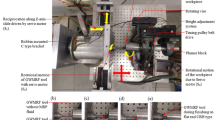Abstract
Notch wear is the main failure mode in finish turning pure iron material, which determines the tool life and has an important effect on machined workpiece surface quality. In this paper, in order to reduce notch wear in finish turning pure iron material, the evolutions and mechanisms of notch wear on cutting tool edge are studied with different cutting parameters and four kinds of cooling/lubrication conditions, such as wet cutting, dry cutting, hand operation to brush rapeseed oil on unmachined workpiece surface, and minimum quantity lubrication (MQL). The results show that two notch wear formations are observed at the major cutting edge and the minor cutting edge on flank face as well as two obvious notch wears on rake face. The main wear mechanisms of notch wear are the seizure/pullout, diffusion wear, and oxidation wear. Cooling/lubrication conditions have an important effect on major and minor notch wear. The major and minor notch wear under wet cutting with different cutting speeds have the largest wear rates, following under dry cutting and rapeseed oil lubrication conditions. MQL condition is suitable for the finish turning of pure iron materials. Therefore, in order to decrease notch wear, in finish turning pure iron material, tool cooling must be minimized and tool lubrication must be favored.
Similar content being viewed by others
References
Tian WS, Yue DQ (1990) A study of pure iron machinability. J TaiYuan Heavy Mach Inst 11(2):17–24
Chen YT, Tang XJ, Li QZ (2010) Shock-induced phase transition and spalling characteristic in pure iron and FeMnNi alloy. Chin Phys B 19(5):1–8
Ferrara E, Olivetti E, Fiorillo F, Forton E, Martino L, Rocchino L (2014) Microstructure and magnetic properties of pure iron for cyclotron electromagnets. J Alloys Compd 615(Supplement 1):S291–S295
Shaw MC (2005) Metal cutting principles. Oxford University Press, New York
Bushlya V, Zhou J, Avdovic P, Ståhl J-E (2013) Wear mechanisms of silicon carbide-whisker-reinforced alumina (Al2O3–SiCw) cutting tools when high-speed machining aged alloy 718. Int J Adv Manuf Technol 68(5–8):1083–1093
Choudhury IA, El-Baradie MA (1998) Machinability of nickel-base super alloys: a general review. J Mater Process Technol 77(1–3):278–284
Tan MT, Zhang YZ (1986) Groove wear of tools in NC turning of pure nickel. CIRP Ann Manuf Technol 35(1):71–74
Sharman ARC, Hughes JI, Ridgway K (2004) Workpiece surface integrity and tool life issues when turning inconel 718 nickel based superalloy. Mach Sci Technol Int J 8(3):399–414
Liu ZQ, Wan Y (2004) Experimental study on wear modes and abrasion rule of PCBN cutting tools. Trans Chin Soc Agric Mach 35(9):229–231
Kasim MS, Che Haron CH, Ghani JA, Sulaiman MA, Yazid MZA (2013) Wear mechanism and notch wear location prediction model in ball nose end milling of inconel 718. Wear 302(1–2):1171–1179
Xiao MH, He N, Li L (2010) Modeling notch wear of ceramic tool in high speed machining of nickel-based superalloy. J Wuhan Univ Technol-Mater 25(1):78–83
He N, Pan LX, Zhang YZ (1995) Notch wear of machining nickel based alloys with ceramic tools. Chin J Mech Eng 8(4):262–266
Zhuang KJ, Zhu DH, Zhang XM, Ding H (2014) Notch wear prediction model in turning of inconel 718 with ceramic tools considering the influence of work hardened layer. Wear 313(1–2):63–74
Ducros C, Benevent V, Sanchette F (2003) Deposition, characterization and machining performance of multilayer PVD coatings on cemented carbide cutting tools. Surf Coat Technol 163–164:681–688
Machado AR, Wallbank J, Pashby IR et al (1998) Tool performance and chip control when machining Ti6Al4V and inconel 901 using high pressure coolant supply. Mach Sci Technol 2:1–12
Olovsjö S, Nyborg L (2012) Influence of microstructure on wear behaviour of uncoated WC tools in turning of alloy 718 and waspaloy. Wear 282–283:12–21
Cedergren S, Olovsjö S, Sjöberg G, Nyborg L (2013) The effects of grain size and feed rate on notch wear and burr formation in wrought alloy 718. Int J Adv Manuf Technol 67:1501–1507
Weinert K, Inasaki I, Sutherland JW, Wakabayashi T (2004) Dry machining and minimum quantity lubrication. CIRP Ann Manuf Technol 53(2):511–537
Shokrani A, Dhokia V, Newman ST (2012) Environmentally conscious machining of difficult-to-machine materials with regard to cutting fluids. Int J Mach Tools Manuf 57:83–101
Biermann D, Iovkov I, Blum H, Rademacher A, Taebi K, Suttmeier FT, Klein N (2012) Thermal aspects in deep hole drilling of aluminium cast alloy using twist drills and MQL. Procedia CIRP 3:245–250
Yan L, Yuan S, Liu Q (2012) Influence of minimum quantity lubrication parameters on tool wear and surface roughness in milling of forged steel. Chin J Mech Eng 25(3):419–429
Kouam J, Songmene V, Balazinske M, Hendrick P (2015) Effects of minimum quantity lubrication (MQL) conditions on machining of 7075-T6 aluminum alloy. Int J Adv Manuf Technol 79:1325–1334
Dhar NR, Kamruzzaman M, Ahmed M (2006) Effect of minimum quantity lubrication (MQL) on tool wear and surface roughness in turning AISI-4340 steel. J Mater Process Technol 172(2):299–304
Kaynak Y (2014) Evaluation of machining performance in cryogenic machining of inconel 718 and comparison with dry and MQL machining. Int J Adv Manuf Technol 72:919–933
Jiang F, Li J, Sun J, Zhang S, Wang Z, Yan L (2009) Al7050-T7451 turning simulation based on the modified power-law material model. Int J Adv Manuf Technol 48(9–12):871–880
Lalwani DI, Mehta NK, Jain PK (2009) Extension of Oxley’s predictive machining theory for Johnson and Cook flow stress model. J Mater Process Technol 209(12–13):5305–5312
Kong JX, Chen H, He N, Li L, Jiang F (2014) Dynamic mechanical property tests and constitutive model of pure iron material. Acta Aeronaut Astronaut Sin 35(7):2063–2071
Author information
Authors and Affiliations
Corresponding author
Rights and permissions
About this article
Cite this article
Kong, J., Xia, Z., Xu, D. et al. Investigation on notch wear mechanism in finish turning pure iron material with uncoated carbide tools under different cooling/lubrication conditions. Int J Adv Manuf Technol 86, 97–105 (2016). https://doi.org/10.1007/s00170-015-8171-2
Received:
Accepted:
Published:
Issue Date:
DOI: https://doi.org/10.1007/s00170-015-8171-2




